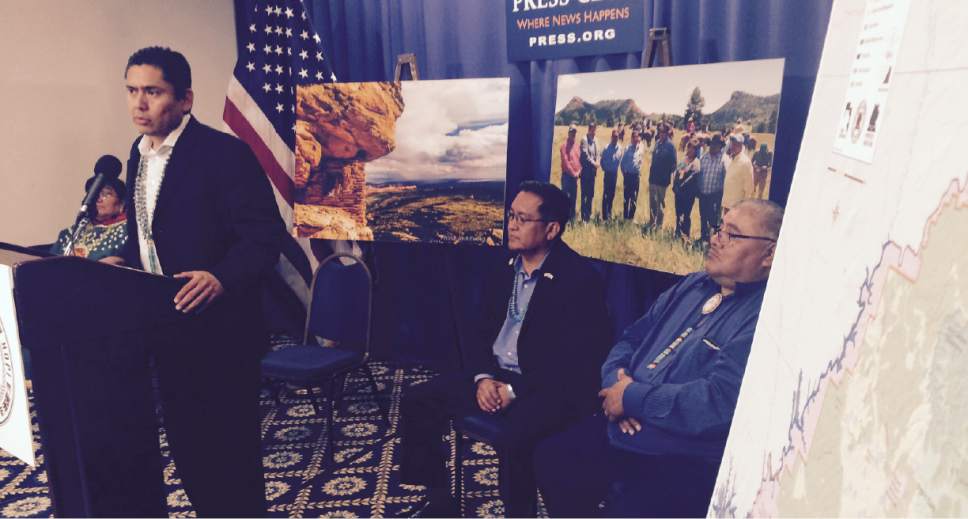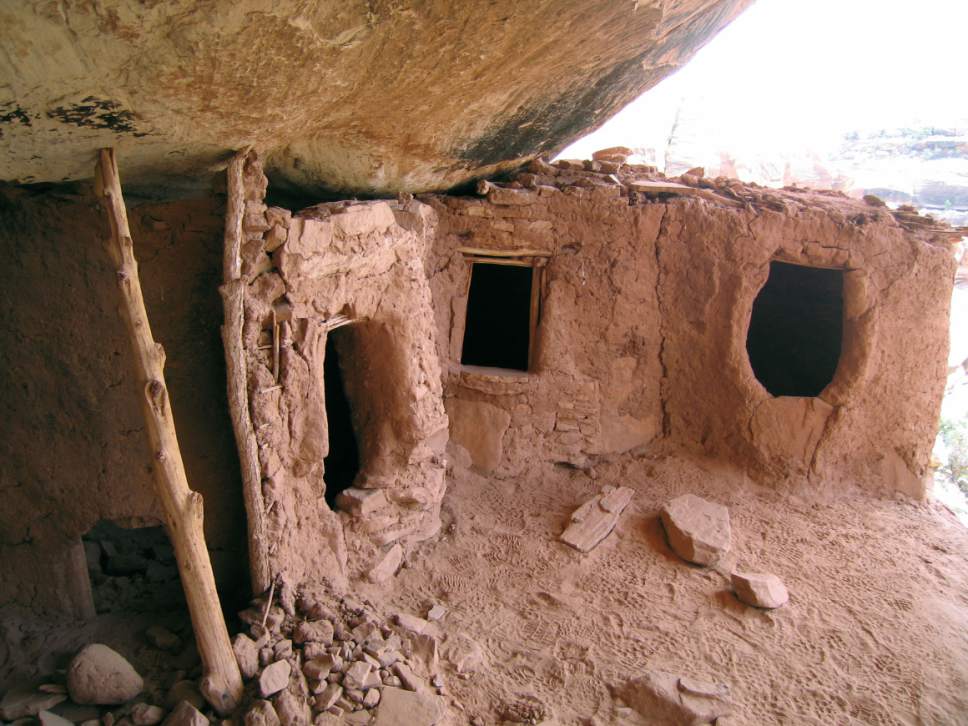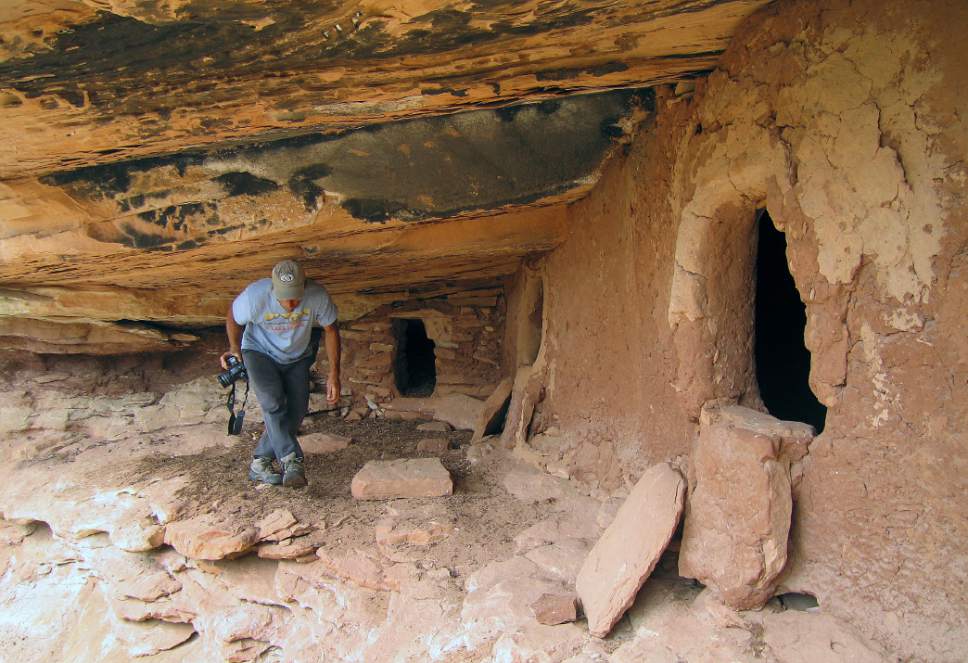This is an archived article that was published on sltrib.com in 2016, and information in the article may be outdated. It is provided only for personal research purposes and may not be reprinted.
Rep. Rob Bishop's draft Public Lands Initiative would set aside 1.1 million acres in San Juan County as a Bears Ears National Conservation Area, but the inter-tribal coalition that is championing the idea called the congressman's proposal "woefully inadequate" for protecting a landscape sacred to the Navajo and Utes and considered an ancestral homeland to nearby Puebloan tribes.
The draft bill offers a scaled-down version of the 1.9 million-acre national monument sought by the Bears Ears Inter-Tribal Coalition for the lands stretching from the San Juan River over Cedar Mesa to the Abajo Mountains. But worse, it provides only token opportunities for tribal influence how the land would be administered, according to Eric Descheenie, a Navajo tribal executive who is a coalition co-chairman.
"The tribes want equal footing over policy and administration," Descheenie said. "We haven't gotten anything substantive in response to that."
Last month, the coalition pulled out of talks with the Rep. Jason Chaffetz and Bishop, complaining San Juan County leaders and Utah's GOP congressmen were not taking its proposal seriously.
The draft bill unveiled Wednesday "adds insult to injury," Descheenie said.
"The draft confirms the inequitable treatment of tribes over the past three years and our need to seek other means of protecting the living cultural landscape we call Bears Ears," the coalition wrote to Bishop and Chaffetz in a letter sent Wednesday. The group is now petitioning the Obama administration to use the Antiquities Act to designate a Bears Ears monument.
Bishop and Chaffetz propose a conservation zone that would be managed in "a way that conserves, protects, and enhances the scenic, biological, natural, historical, scientific, recreational, ecological, educational, scientific, and cultural resources of the area while maintaining access via motorized and nonmotorized uses to sacred sites, historical and recreational places, and gathering and hunting grounds."
At Wednesday's unveiling of the draft bill, Chaffetz defended his office's efforts to include all relevant stakeholders in the complicated process to draft a bill in which all sides were expected to make concessions.
"It's a huge swath of land. If you look at the way the management of what is proposed under the PLI, you have an equal participation with the Native American representation as you do with state and county interest as well as [the Bureau of Land Management]," said Chaffetz, whose district covers much of the land affected by the PLI. "I take great exception to the idea that we have not heard or spent time addressing concerns of Native Americans. I have flown and met with the Navajo Nation president and had groups in my office as late as December hearing their thoughts and ideas, and we will continue to listen."
He and Bishop counseled that a national conservation area, or NCA, would offer greater flexibility than a monument designated by the president under the Antiquities Act. An NCA is a better way, they said, to ensure traditional uses of this landscape, such as firewood and herb-gathering and spiritual ceremonies, sought by tribal members.
"It would be ill-advised to go with a monument. It sells our nation and our state short. You can't do nearly as much with a designation as you can with this bill," Chaffetz said. "We will have more Native American participation of what we can do in a congressional direction than the president can do unilaterally."
Tribal leaders say preservation of the land is paramount to their communities' interest, and the PLI does not go far enough.
"This is very energy focused. The land needs to be healed and needs time to rest so it can continue to produce the plant life and the animal life," said Regina Lopez-Whiteskunk of the Ute Mountain Utes, a Colorado-based tribe with a Utah community at White Mesa. "I advocate for more of a decision-making capacity. The federal government continues to put tribes in an advisory role, when we need to be at the table as equal decision makers. Look at how much we have already lost. That's a slap in the face compared with what we proposed."
Chaffetz's draft does envision designating 225,601 acres of wilderness on Cedar Mesa. The document proposes far more conservation than what the county proposed, even though San Juan was "generous" on offering lands for wilderness, according to County Commission Chairman Phil Lyman.
"You get to the point where you just shrug your shoulders," Lyman said. "We just want some concessions back to the county, just so we're able to plan our future and have an economy that's viable."
Yet another sticking point is the spiderweb of routes to which San Juan County is seeking title. The Bishop bill would cede most of these routes, currently tied up in litigation with the federal government, to the state, including some on Cedar Mesa.
Brian Maffly covers public lands for The Salt Lake Tribune. Maffly can be reached at bmaffly@sltrib.com or 801-257-8713. Twitter: @brianmaffly







